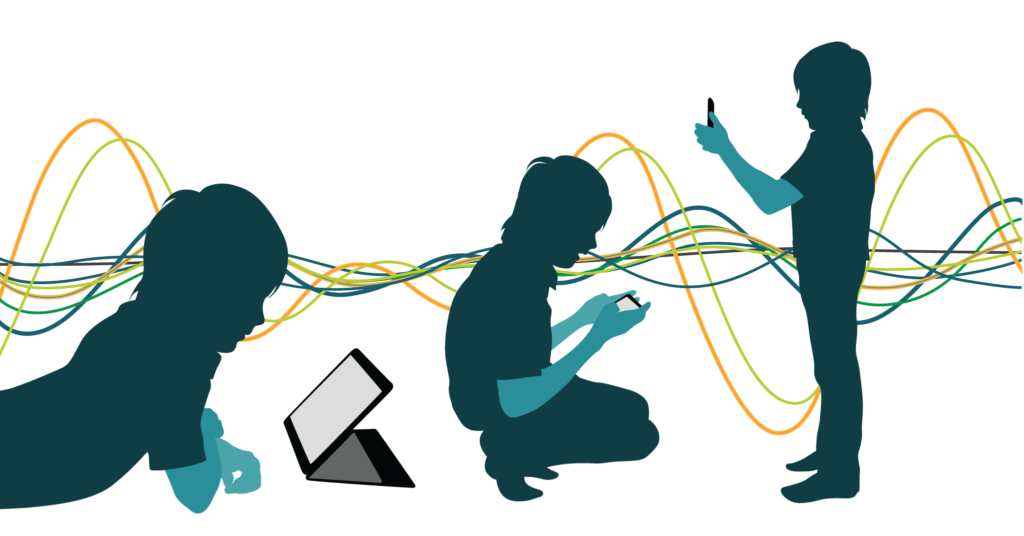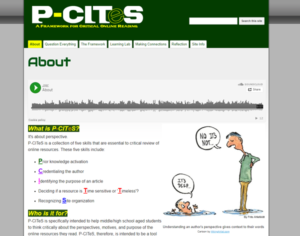Two educators share their experiences teaching digital literacy
Last week, I had the great pleasure of speaking to two educators about their experiences teaching digital literacy.
The conversations that emerged were eye-opening.
Both teachers have taught — or are currently teaching — digital literacy to their students. The contexts in which they taught this subject, however, were very different.
For Jeff Gerlach, it all began seven years ago in his face-to-face, 7th-grade social studies classroom.
For Kevin Santer, the journey began this semester, in a fully online format, as the instructor of our new Digital Literacy & Programming course for middle school students.
Despite differences in the affordances and limitations of these environments, both Jeff and Kevin provided thoughtful reflections on what “digital literacy” means, why it matters, how far we’ve come and what lies ahead for the next generation of “digital natives.”
Meet our protagonists
 Jeff Gerlach began teaching digital literacy over seven years ago during his time as a social studies teacher at Wayne-Westland Community School District in Westland, MI. After earning his master’s degree in Educational Technology at Michigan State University, he joined our Michigan Virtual staff as a member of our professional learning team, supporting educators as an instructional design coach.
Jeff Gerlach began teaching digital literacy over seven years ago during his time as a social studies teacher at Wayne-Westland Community School District in Westland, MI. After earning his master’s degree in Educational Technology at Michigan State University, he joined our Michigan Virtual staff as a member of our professional learning team, supporting educators as an instructional design coach. Kevin Santer began his career by working in IT as a software developer, designer and manager. He made the bold move of returning to school to earn a master’s degree in math education. Kevin then taught face-to-face for 10 years, exploring math and computer science with high school students. He now serves as our Lead Instructor in Career & Technical Education at Michigan Virtual.
Kevin Santer began his career by working in IT as a software developer, designer and manager. He made the bold move of returning to school to earn a master’s degree in math education. Kevin then taught face-to-face for 10 years, exploring math and computer science with high school students. He now serves as our Lead Instructor in Career & Technical Education at Michigan Virtual.Jeff’s story

Teaching students to boldly go where plenty of people have already been. . .
The educational context
In 2011, Jeff Gerlach was teaching social studies to students at Wayne-Westland Community School District when he developed the PCITeS framework.
What’s PCITeS? It’s an acronym Jeff developed to get students to think critically about the resources they encountered on the Internet.
Here’s what it stands for:
C = Credentialing the Author
I = Identifying the purpose of an article
Deciding if a resource is T= Time sensitive or Timeless
Recognize S= Site organization
The website he created functioned as a self-paced module for his blended classroom. On this site, he encourages students to “question everything” and provides them opportunities to practice critical thinking skills in digital spaces.
The framework isn’t revolutionary, he acknowledges. It takes widely-accepted critical reading strategies and modifies them for the internet era.
But as a social studies teacher, he felt he had an obligation to walk his middle-schoolers through these basic steps.
Why digital literacy matters
“I define digital literacy as information literacy,” Jeff says. “The Internet is a place for learning. But the information that exists there is noisier, more abundant and less certain than print-based texts.”
This creates unstable ground for even the most brazen of digital pioneers to explore.
“I think we’re programmed, cognitively, when we’re introduced with new information, in order to absorb it, we have to believe that it’s true,” he says. “Left unchecked without a critical eye, however, the naive person accepts everything as truth.”
There’s a tension here
Being overly critical can inhibit learning; however, this critical awareness becomes a powerful tool when it allows students to interpret all truths as tentative.
That was his goal when teaching his students digital literacy. To make learning tentative. To teach students that they need to triangulate facts with different sources before accepting them as truth.
It’s natural for teachers to feel timid in encouraging their students to explore digital spaces. But, increasingly, as time goes on, this is less and less of an option.
Looking back: What’s changed?
Reflecting on this exercise he developed seven years ago, Jeff says he still stands by most of the content, with a few adjustments.
First off, he wishes he could have spent more time connecting the PCITeS framework to the rest of his curriculum to really hit the message home. “I wish it had been more instilled in the fabric of how students did business in my class.”
The Internet is a constantly-evolving space. Things have changed since he first began teaching the PCITeS framework.
We can teach basic principles of digital literacy, it seems. But more important than teaching students to investigate any static criterion over another, we ought to teach them how to pay attention to the shifting tectonic plates of our digital world.
This world is changing, faster than ever, and it’s our duty as educators to teach students to approach, critically and thoughtfully, this dynamic space that’s always in flux.
Kevin’s story
When teaching digital literacy means aiming at a moving target…
Teaching digital literacy is a lot like aiming at a moving target. That’s how Kevin Santer describes it, anyway.
Because digital spaces are always changing, always evolving. There is no set of “rules” that can be easily transferred to students. That’s why it’s so important that we give students the tools to track this target and proceed with a cautious and critical mindset.
The educational context
This is Kevin’s first time teaching Michigan Virtual’s Digital Literacy & Programming course for middle school students.
This course is a little different than Jeff’s, both in terms of its goal and its setting.
For starters, it’s a fully online course. This semester — the first time this course has been offered — he has a unique scenario. He’s teaching asynchronously to students who all share the same brick and mortar classroom.
Furthermore — unlike Jeff’s self-paced module — Kevin’s entire course is devoted to exploring fundamentals of internet citizenship — from performing research on the internet; to discussing the harms of cyberbullying; to learning the basics of programming languages, the Microsoft suite and photoshop.
So far, he’s been impressed with the ability of his students to engage with the material. In the unit on cyberbullying, for example, they were presented with some difficult stories of students being driven to suicide by internet abuse.
“There were some really tough stories. But they engaged really deeply with it. Much more than the typical ‘I’m only responding to get this assignment done.'”
If given the opportunity, he believes, students are generally interested and willing to think about these topics in a thoughtful way.
Why digital literacy matters
Kevin has concerns about our use of the term “digital natives” to describe the next generation of netizens.
“As much as we talk about students today being ‘digital natives,’ they aren’t always aware of what’s going on beneath the hood. There are some dangers there, especially for younger kids. They don’t have the same skepticism that non-natives might have.”
His point is this:
It’s easy sometimes to assume that students today have an intuitive grasp on digital literacy. To some extent, this is true. But the other side of the coin is the fact that today’s students are so habituated to digital environments that they might not always think to peer behind the curtain to examine who or what is pulling the strings.
Of course, this isn’t always the case.
As a counterexample, he told me a story about a student who adamantly refuses to sign up for social media and articulates eloquently his reasons for choosing to go off the grid.
Many of even our youngest students are already developing a critical awareness of the tools at their fingertips. This is a mindset we ought to foster as educators.
Why is this so important?
“They’re just so vulnerable,” he says. “Especially at this age.”
This becomes particularly obvious in the unit on cyberbullying.
And that’s where, he believes, we are heading with digital literacy instruction.
We’ve all felt the effects of fake news and misinformation.
“Some of our motivation for pushing ethics in digital literacy comes from an altruistic place. But some of it is also defensive. We’ve been mislead. We’ve been betrayed.”
In response to this collectively misplaced trust, we’ve developed a series of moral imperatives for teaching students to not fall for the tricks that have befallen us.
We want to teach them how to be not simply digital natives, but also digital citizens.
Our question then becomes: Can we agree upon a vision for digital citizenship? Do we need to?



